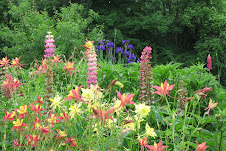Today was a glorious spring-like day. Although a somewhat cool wind was blowing and the sun was intermittantly obscured by clouds, bright patches and stretches of blue sky burst through regularly, and the sun beat down warmly. Even the slick layer of snow that has frosted our yards has vanished since yesterday evening. With temperatures exceeding the low 60s, I was not surprised to spy a few errant insects who had roused themselves from their winter slumber to buzz by drowsily.
For those who have spent the better part of the winter trapped indoors, days like this (particularly as it comes at the end of what has been a three-day weekend for many people) can lead to an overwhelming urge to be in the garden and get a jump on spring clean-ups.
Although the beginning (or overzealous) gardener might surmise that getting a headstart on clearing the beds of dead leaves, dried stalks, wind-barren seed pods, pine needles, and other winter detritus is a sensible (not to mention enjoyable) way to spend a day like this, I would strongly caution you to resist such well-intentioned efforts.
Winter thaws, even as brief as this one, have a tendency to stir some plants from dormancy. You may have noticed, for example, that some of your spring-flowering bulbs, most notably daffodils, have begun to poke up through the ground, as a result of slightly milder temperatures (although, as a side note, this sometimes occurs as the result of a period of milder temperatures that may have stimulated slight growth all the way back in late fall). Nevertheless, such stirrings are not a sign that is is safe to uncover your plants from the protective covering of store-bought mulch or a thick mat of leaves.
As those of us know who have lived our entire lives in the northeast, the danger of bitter cold temperatures and damaging storms is still far from being over. If the mercury does fall or a heavy ice storm does occur, plants that lack protection will be extremely vulnerable and may not survive. Thus, not only do I caution our customers not to uncover their plants, but I also recommend that they still refrain from removing last year's dead growth, as even this can add a bit of protection to your favorite perennials. Additionally, as I've written before, much of this growth adds winter interest should your property be again buried beneath a snowy blanket. I, for one, prefer to see the ghosts of seasons past to scanning a flat, uninterrupted landscape. Besides, many of these plants still serve as perches for resident birds (one of my favorite sights in winter is to watch our chickadees swinging happily on the seven foot tall fronds of our ornamental grasses!).
If, despite reading the above, you really must get your hands dirty, I suggest a day of re-potting houseplants. Often neglected, many houseplants will be grateful for a larger container (or division when they have reproduced beyond the accomodation of their pots). Even more important, particularly for those of you who may not fertilize as regularly as you ought to, re-potting provides your plant with fresh and more nutritious soil, for a healthier, happier plant that will often reward you with a sudden growth spurt. Best of all, the typically messy task of re-potting offers you the perfect excuse to enjoy the weather by working on a surface outdoors. Just be sure to bring your plants inside before the temperatures fall below 55 degrees and never water them in with frigid water from an outdoor tap (indoor room temperature is best).
Happy President's Day!
Monday, February 18, 2008
Subscribe to:
Post Comments (Atom)

No comments:
Post a Comment